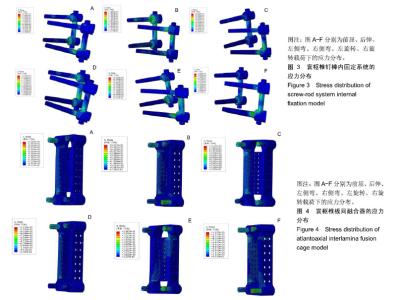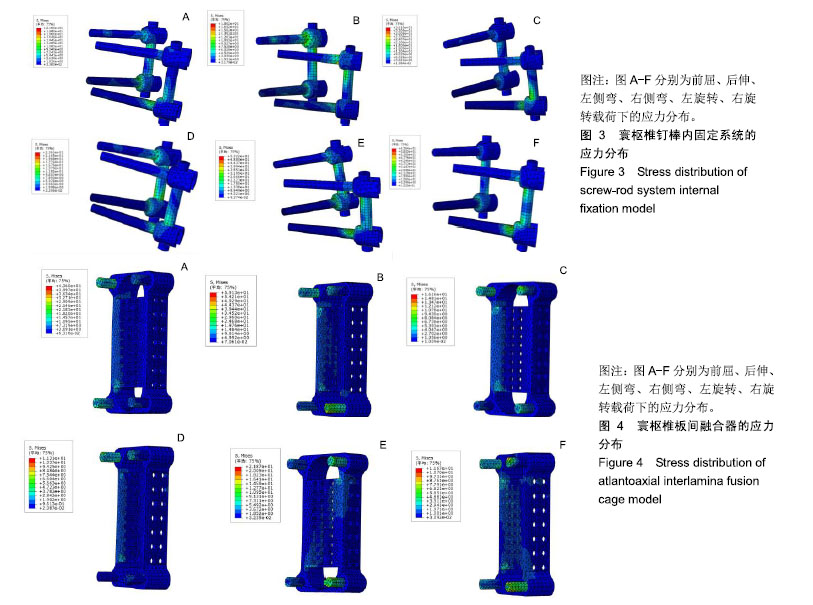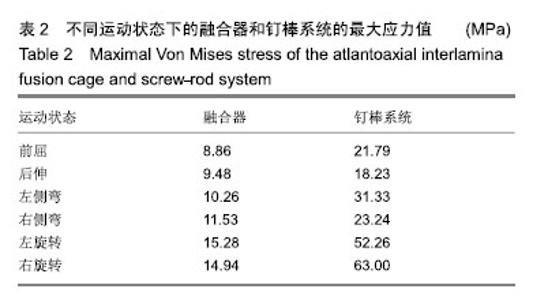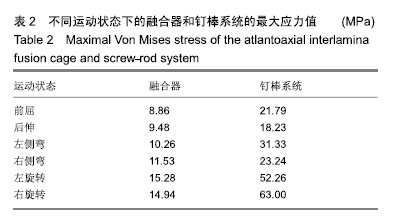Chinese Journal of Tissue Engineering Research ›› 2019, Vol. 23 ›› Issue (28): 4529-4534.doi: 10.3969/j.issn.2095-4344.1340
Previous Articles Next Articles
Finite element analysis of biomechanical properties of a novel posterior interlamina fusion cage
Zou Xiaobao, Ma Xiangyang, Yang Haozhi, Ge Su, Chen Yuyue, Xia Hong, Wu Zenghui
- Department of Orthopedics, General Hospital of Southern Theater Command, Guangzhou 510010, Guangdong Province, China
-
Online:2019-10-08Published:2019-10-08 -
Contact:Ma Xiangyang, MD, Professor, Chief physician, Doctoral supervisor, Department of Orthopedics, General Hospital of Southern Theater Command, Guangzhou 510010, Guangdong Province, China -
About author:Zou Xiaobao, Master, Physician, Department of Orthopedics, General Hospital of Southern Theater Command, Guangzhou 510010, Guangdong Province, China -
Supported by:the Science and Technology Department of Guangdong Province, No. 2015B020233013 (to MXY)| the Science and Technology Department of Guangzhou, No. 201803010046 (to MXY)
CLC Number:
Cite this article
Zou Xiaobao, Ma Xiangyang, Yang Haozhi, Ge Su, Chen Yuyue, Xia Hong, Wu Zenghui. Finite element analysis of biomechanical properties of a novel posterior interlamina fusion cage[J]. Chinese Journal of Tissue Engineering Research, 2019, 23(28): 4529-4534.
share this article
| [1]Yin QS, Wang JH. Current Trends in Management of Atlantoaxial Dislocation. Orthop Surg, 2015;7(3):189-199.[2]尹庆水,艾福志,夏虹,等. 寰枢椎前路复位钢板系统的研制及其生物力学[J].中华创伤骨科杂志, 2004, 1(2):54-57.[3]Wei G, Wang Z, Ai F, et al. Treatment of basilar invagination with klippel-feil syndrome: atlantoaxial joint distraction and fixation with transoral atlantoaxial reduction plate. Neurosurgery. 2016;78(4): 492-498.[4]Richter M, Schmidt R, Claes L, et al. Posterior atlantoaxial fixation: biomechanical in vitro comparison of six different techniques. Spine (Phila Pa 1976). 2002; 27(16):1724-1732.[5]Yin QS, Ai FZ, Zhang K, et al. Transoral atlantoaxial reduction plate internal fixation for the treatment of irreducible atlantoaxial dislocation: a 2- to 4-year follow-up. Orthop Surg. 2010; 2(2): 149-155.[6]Xia H, Yin Q, Ai F, et al. Treatment of basilar invagination with atlantoaxial dislocation: atlantoaxial joint distraction and fixation with transoral atlantoaxial reduction plate (TARP) without odontoidectomy. Eur Spine J. 2014;23(8):1648-1655.[7]Yi QS, Li XS, Bai ZH, et al. An 11-Year Review of the TARP Procedure in the Treatment of Atlantoaxial Dislocation. Spine (Phila Pa 1976). 2016;41(19):E1151-E1158.[8]Yin Q, Ai F, Zhang K, et al. Irreducible anterior atlantoaxial dislocation: one-stage treatment with a transoral atlantoaxial reduction plate fixation and fusion. Report of 5 cases and review of the literature. Spine (Phila Pa 1976). 2005; 30(13): E375-E381.[9]Sim HB, Lee JW, Park JT, et al. Biomechanical evaluations of various c1-c2 posterior fixation techniques. Spine (Phila Pa 1976). 2011; 36(6):E401-E407.[10]Park J, Scheer JK, Lim TJ, et al. Biomechanical analysis of Goel technique for C1-2 fusion. J Neurosurg Spine. 2011; 14(5): 639-646.[11]Melcher RP, Puttlitz CM, Kleinstueck FS, et al. Biomechanical testing of posterior atlantoaxial fixation techniques. Spine (Phila Pa 1976). 2002; 27(22):2435-2440.[12]马向阳,尹庆水,吴增晖,等. 寰枢椎后路四种钉棒固定方法的三维稳定性评价[J]. 中国脊柱脊髓杂志, 2008, 18(6):464-468.[13]Claybrooks R, Kayanja M, Milks R, et al. Atlantoaxial fusion: a biomechanical analysis of two C1-C2 fusion techniques. Spine J. 2007;7(6):682-688.[14]马向阳,尹庆水,吴增晖,等. 多种寰枢椎后路钉棒固定技术的临床组合应用[J]. 中国骨科临床与基础研究杂志, 2010,2(1):12-16.[15]Bhowmick DA, Benzel EC. Posterior atlantoaxial fixation with screw-rod constructs: safety, advantages, and shortcomings. World Neurosurg. 2014;81(2):288-289.[16]Hwang IC, Kang DH, Han JW, et al. Clinical experiences and usefulness of cervical posterior stabilization with polyaxial screw-rod system. J Korean Neurosurg Soc. 2007;42(4): 311-316.[17]Meyer B, Kuhlen D. Atlantoaxial fusion: transarticular screws versus screw-rod constructs. World Neurosurg. 2013;80(5): 516-517.[18]Elliott RE, Tanweer O, Boah A, et al. Outcome comparison of atlantoaxial fusion with transarticular screws and screw-rod constructs: meta-analysis and review of literature. J Spinal Disord Tech. 2014;27(1):11-28.[19]Harms J, Melcher RP. Posterior C1-C2 fusion with polyaxial screw and rod fixation. Spine (Phila Pa 1976). 2001; 26(22): 2467-2471.[20]Stulik J, Vyskocil T, Sebesta P, et al. Atlantoaxial fixation using the polyaxial screw-rod system. Eur Spine J.2007;16(4): 479-484.[21]Guo SL, Zhou DB, Yu XG, et al. Posterior C1-C2 screw and rod instrument for reduction and fixation of basilar invagination with atlantoaxial dislocation. Eur Spine J. 2014;23(8):1666-1672.[22]Qi L, Li M, Zhang S, et al. C1-c2 pedicle screw fixation for treatment of old odontoid fractures. Orthopedics. 2015;38(2): 94-100.[23]马向阳,杨进城,邱锋,等. 寰枢椎脱位后路植骨材料的选择与融合效果评价[J]. 中国骨科临床与基础研究杂志, 2015, 7(1):5-9.[24]He X, Meng Y, Zhang J, et al. Bone grafting of atlantoaxial joints and occipitocervical or atlantoaxial fusion for the reduction and fixation of basilar invagination with atlantoaxial dislocation by a posterior approach: a preliminary study. World Neurosurg. 2017.[25]张皓南,尹庆水,刘桂英,等. 经口前路寰枢椎侧块关节融合器的力学稳定性评价[J]. 中国临床解剖学杂志, 2014, 3(3):348-350.[26]Zhang BC, Liu HB, Cai XH, et al. Biomechanical comparison of a novel transoral atlantoaxial anchored cage with established fixation technique - a finite element analysis. BMC Musculoskelet Disord. 2015;16:261. [27]陈树金,马向阳,杨进城,等.有限元法分析寰-枢椎椎弓根螺钉内固定的生物力学变化[J].中国组织工程研究, 2018,22(31): 4970-4974.[28]Faizan A, Goel VK, Garfin SR, et al. Do design variations in the artificial disc influence cervical spine biomechanics? A finite element investigation. Eur Spine J. 2012;21 Suppl 5: S653-662. [29]关哲,马迅,梁凯恒,等.上颈椎有限元模型的建立及寰椎生物力学有限元分析[J].中国脊柱脊髓杂志,2009,19(7):530-534. [30]Zhang H, Bai J. Development and validation of a finite element model of the occipito-atlantoaxial complex under physiologic loads. Spine (Phila Pa 1976). 2007;32(9): 968-974. [31]杨敏,马向阳,杨进城,等.自行防旋转寰枢椎钉棒内固定系统的生物力学有限元分析[J].中国组织工程研究, 2017,21(19):3031-3037.[32]Ma X, Peng X, Xiang H, et al. A finite element modeling of posterior atlantoaxial fixation and biomechanical analysis of C2 intralaminar screw fixation. Chin Med J (Engl).2014;127(7): 1266-1271. [33]Lapsiwala SB,Anderson PA,Oza A,et al.Biomechanical comparison of four C1 to C2 rigid fixative techniques: anterior transarticular, posterior transarticular, C1 to C2 pedicle, and C1 to C2 intralaminar screws.Neurosurgery. 2006;58(3): 516-521. [34]邹小宝,马向阳,杨进城,等. 寰枢椎脱位不同植骨材料及内固定方式对植骨后融合时间的影响[J].中国组织工程研究, 2017, 21(11): 1688-1694. [35]廖文胜,刘玉峰,鲍恒,等.经口前路寰枢椎侧块关节间固定融合器的研制及生物力学分析[J].郑州大学学报(医学版),2013,48(5): 658-661. [36]Zhang B, Liu H, Cai X,et al. Biomechanical comparison of modified tarp technique versus modified goel technique for the treatment of basilar invagination: a finite element analysis. Spine (Phila Pa 1976). 2016; 41(8):E459-466.[37]邹小宝,马向阳,杨进城,等. 经口咽前路减压侧块关节融合器植骨融合联合颈椎压力固定器治疗难复性寰枢椎脱位[J]. 中国脊柱脊髓杂志, 2016,26(11):961-966.[38]Matsumoto M, Chiba K, Tsuji T, et al. Use of a titanium mesh cage for posterior atlantoaxial arthrodesis. Technical note. J Neurosurg. 2002;96(1 Suppl):127-130.[39]Chun HJ, Oh SH, Yi HJ, et al. Efficacy and durability of the titanium mesh cage spacer combined with transarticular screw fixation for atlantoaxial instability in rheumatoid arthritis patients. Spine (Phila Pa 1976). 2009;34(22):2384-2388. [40]Ryu JI, Bak KH, Yi HJ, et al. Evaluation of the Efficacy of Titanium Mesh Cages with Posterior C1 Lateral Mass and C2 Pedicle Screw Fixation in Patients with Atlantoaxial Instability. World Neurosurg. 2016;90:103-108. [41]Goel A, Kulkarni AQ, Sharma P. Reduction of fixed atlantoaxial dislocation in 24 cases: technical note. J Neurosurg Spine. 2005; 2(4):505-509.[42]Li S, Ni B, Xie N, et al. Biomechanical evaluation of an atlantoaxial lateral mass fusion cage with C1-C2 pedicle fixation. Spine (Phila Pa 1976). 2010; 35(14):E624-E632. [43]李胜华,汪康,夏良政,等. 后路寰枢椎侧块关节融合器置入的临床应用解剖[J]. 中国骨与关节损伤杂志, 2012, 27(5):385-388.[44]Yoshizumi T, Murata H, Ikenishi Y, et al. Occipitocervical fusion with relief of odontoid invagination: atlantoaxial distraction method using cylindrical titanium cage for basilar invagination--case report. Neurosurg Rev. 2014; 37(3):519-525. [45]Lee JY, Im SB, Jeong JH. Use of a c1-c2 facet spacer to treat atlantoaxial instability and basilar invagination associated with rheumatoid arthritis. World Neurosurg. 2017;98:874.e13-874. |
| [1] | Xu Feng, Kang Hui, Wei Tanjun, Xi Jintao. Biomechanical analysis of different fixation methods of pedicle screws for thoracolumbar fracture [J]. Chinese Journal of Tissue Engineering Research, 2021, 25(9): 1313-1317. |
| [2] | Chen Xinmin, Li Wenbiao, Xiong Kaikai, Xiong Xiaoyan, Zheng Liqin, Li Musheng, Zheng Yongze, Lin Ziling. Type A3.3 femoral intertrochanteric fracture with augmented proximal femoral nail anti-rotation in the elderly: finite element analysis of the optimal amount of bone cement [J]. Chinese Journal of Tissue Engineering Research, 2021, 25(9): 1404-1409. |
| [3] | Zhou Jihui, Li Xinzhi, Zhou You, Huang Wei, Chen Wenyao. Multiple problems in the selection of implants for patellar fracture [J]. Chinese Journal of Tissue Engineering Research, 2021, 25(9): 1440-1445. |
| [4] | Song Chengjie, Chang Hengrui, Shi Mingxin, Meng Xianzhong. Research progress in biomechanical stability of lateral lumbar interbody fusion [J]. Chinese Journal of Tissue Engineering Research, 2021, 25(6): 923-928. |
| [5] | Liu Zhao, Xu Xilin, Shen Yiwei, Zhang Xiaofeng, Lü Hang, Zhao Jun, Wang Zhengchun, Liu Xuzhuo, Wang Haitao. Guiding role and prospect of staging and classification combined collapse prediction method for osteonecrosis of femoral head [J]. Chinese Journal of Tissue Engineering Research, 2021, 25(6): 929-934. |
| [6] | Xu Yulin, Shen Shi, Zhuo Naiqiang, Yang Huilin, Yang Chao, Li Yang, Zhao Heng, Zhao Lu. Biomechanical comparison of three different plate fixation methods for acetabular posterior column fractures in standing and sitting positions [J]. Chinese Journal of Tissue Engineering Research, 2021, 25(6): 826-830. |
| [7] | Cai Qunbin, Zou Xia, Hu Jiantao, Chen Xinmin, Zheng Liqin, Huang Peizhen, Lin Ziling, Jiang Ziwei. Relationship between tip-apex distance and stability of intertrochanteric femoral fractures with proximal femoral anti-rotation nail: a finite element analysis [J]. Chinese Journal of Tissue Engineering Research, 2021, 25(6): 831-836. |
| [8] | Xie Chongxin, Zhang Lei. Comparison of knee degeneration after anterior cruciate ligament reconstruction with or without remnant preservation [J]. Chinese Journal of Tissue Engineering Research, 2021, 25(5): 735-740. |
| [9] | Nie Shaobo, Li Jiantao, Sun Jien, Zhao Zhe, Zhao Yanpeng, Zhang Licheng, Tang Peifu. Mechanical stability of medial support nail in treatment of severe osteoporotic intertrochanteric fracture [J]. Chinese Journal of Tissue Engineering Research, 2021, 25(3): 329-333. |
| [10] | Tan Jiachang, Yuan Zhenchao, Wu Zhenjie, Liu Bin, Zhao Jinmin. Biomechanical analysis of elastic nail combined with end caps and wire fixation for long oblique femoral shaft fractures [J]. Chinese Journal of Tissue Engineering Research, 2021, 25(3): 334-338. |
| [11] | Chen Lu, Zhang Jianguang, Deng Changgong, Yan Caiping, Zhang Wei, Zhang Yuan. Finite element analysis of locking screw assisted acetabular cup fixation [J]. Chinese Journal of Tissue Engineering Research, 2021, 25(3): 356-361. |
| [12] | Zhou Jihui, Li Xinzhi, Zhou You, Huang Wei, Chen Wenyao. Comparison of the advantages and disadvantages of multiple implants in treatment of traumatic dislocation of sternoclavicular joint [J]. Chinese Journal of Tissue Engineering Research, 2021, 25(3): 443-448. |
| [13] | Li Kun, Li Zhijun, Zhang Shaojie, Gao Shang, Sun Hao, Yang Xi, Wang Xing, Dai Lina . A 4-year-old child model of occipito-atlanto-axial joints established by finite element dynamic simulation [J]. Chinese Journal of Tissue Engineering Research, 2021, 25(24): 3773-3778. |
| [14] | Shu Qihang, Liao Yijia, Xue Jingbo, Yan Yiguo, Wang Cheng. Three-dimensional finite element analysis of a new three-dimensional printed porous fusion cage for cervical vertebra [J]. Chinese Journal of Tissue Engineering Research, 2021, 25(24): 3810-3815. |
| [15] | Sun Maji, Wang Qiuan, Zhang Xingchen, Guo Chong, Yuan Feng, Guo Kaijin. Development and biomechanical analysis of a new anterior cervical pedicle screw fixation system [J]. Chinese Journal of Tissue Engineering Research, 2021, 25(24): 3821-3825. |
| Viewed | ||||||
|
Full text |
|
|||||
|
Abstract |
|
|||||



